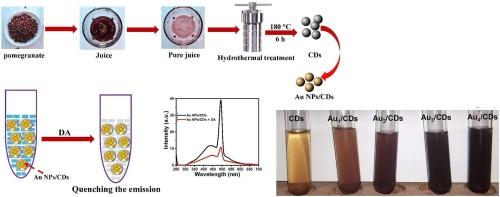Design and green synthesis of carbon Dots/Gold nanoparticles Composites and their applications for neurotransmitters sensing based on emission Spectroscopy
IF 4.3
2区 化学
Q1 SPECTROSCOPY
Spectrochimica Acta Part A: Molecular and Biomolecular Spectroscopy
Pub Date : 2024-11-05
DOI:10.1016/j.saa.2024.125402
引用次数: 0
Abstract
Changes in the neurotransmitters are indications for several diseases. Several sensors were reported for monitoring dopamine (DA), but the simple and accurate DA detection in biological samples still faces many challenges. The research proposal aims to develop an optical sensor for detecting neurotransmitters based on luminescence emission spectra in different biological samples. Carbon dots (CDs) were fabricated based on a green synthesis route. Then the prepared CDs were decorated with varying concentrations of gold nanoparticles (Au NPs). The synthesis process was optimized, and the obtained CDs/Au NPs nanocomposites were applied as neurotransmitters’ optical nanosensors. The optical nanosensor approach provides easy and sensitive multiplex analysis. A wide range of neurotransmitters was monitored. The developed sensor’s sensitivity, selectivity, and reproducibility were investigated. Au NPs act as CDs’ stabilizers, enhancing the emission effect, and scaffolds for binding DA with CDs’ surface. DA moieties bind to CDs through the interaction between the DA-NH2 groups and Au NPS. Due to electron transfer, the bonding of DA molecules leads to fluorescence quenching of AuNPs/CDs. The Au-CDs-based DA fluorescence showed high sensitivity with a detection limit, and limit quantification of 2.04 nM and 6.18 nM, respectively. Furthermore, the selectivity of the sensor was investigated in the presence of glucose, uric acid (UA), and ascorbic acid (AA), which showed no interference effect at 10 times higher concentrations. Moreover, the proposed sensor has been successfully utilized for DA detection in human serum samples with a high recovery efficiency between 98.83 % and 103.5 %.

碳点/金纳米粒子复合材料的设计与绿色合成及其在基于发射光谱的神经递质传感中的应用。
神经递质的变化是多种疾病的征兆。目前已报道了几种用于监测多巴胺(DA)的传感器,但如何简单准确地检测生物样本中的多巴胺仍面临许多挑战。该研究提案旨在开发一种基于不同生物样本中发光发射光谱的神经递质检测光学传感器。研究人员采用绿色合成路线制备了碳点(CD)。然后用不同浓度的金纳米粒子(Au NPs)装饰所制备的碳点。优化合成工艺后,得到的 CDs/Au NPs 纳米复合材料被用作神经递质的光学纳米传感器。该光学纳米传感器方法提供了简便灵敏的多重分析。可监测多种神经递质。研究了所开发传感器的灵敏度、选择性和再现性。金 NPs 既是 CD 的稳定剂,可增强发射效应,又是 DA 与 CD 表面结合的支架。DA 分子通过 DA-NH2 基团与 Au NPS 之间的相互作用与 CD 结合。由于电子转移,DA 分子的结合导致 AuNPs/CDs 的荧光淬灭。基于 Au-CDs 的 DA 荧光具有很高的灵敏度,检测限和定量限分别为 2.04 nM 和 6.18 nM。此外,还研究了该传感器在葡萄糖、尿酸(UA)和抗坏血酸(AA)存在下的选择性,结果表明在 10 倍以上的浓度下无干扰效应。此外,该传感器已成功用于人体血清样品中 DA 的检测,回收率高达 98.83 % 至 103.5 %。
本文章由计算机程序翻译,如有差异,请以英文原文为准。
求助全文
约1分钟内获得全文
求助全文
来源期刊
CiteScore
8.40
自引率
11.40%
发文量
1364
审稿时长
40 days
期刊介绍:
Spectrochimica Acta, Part A: Molecular and Biomolecular Spectroscopy (SAA) is an interdisciplinary journal which spans from basic to applied aspects of optical spectroscopy in chemistry, medicine, biology, and materials science.
The journal publishes original scientific papers that feature high-quality spectroscopic data and analysis. From the broad range of optical spectroscopies, the emphasis is on electronic, vibrational or rotational spectra of molecules, rather than on spectroscopy based on magnetic moments.
Criteria for publication in SAA are novelty, uniqueness, and outstanding quality. Routine applications of spectroscopic techniques and computational methods are not appropriate.
Topics of particular interest of Spectrochimica Acta Part A include, but are not limited to:
Spectroscopy and dynamics of bioanalytical, biomedical, environmental, and atmospheric sciences,
Novel experimental techniques or instrumentation for molecular spectroscopy,
Novel theoretical and computational methods,
Novel applications in photochemistry and photobiology,
Novel interpretational approaches as well as advances in data analysis based on electronic or vibrational spectroscopy.

 求助内容:
求助内容: 应助结果提醒方式:
应助结果提醒方式:


